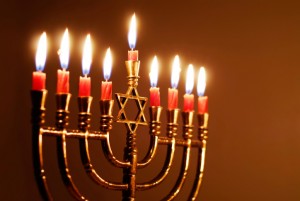
During the holiday season, Jews celebrate Hanukkah, which is known as the Festival of Lights or Feast of Dedication. Although Hanukkah is not ordained in the Bible, it is still widely celebrated around the world. The dates for this eight-day holiday vary every year. In 2015, it begins at sunset on December 6 and continues until nightfall on December 14. Here’s some basic information about Hanukkah so that you have an understanding of it. Even if you don’t have Jewish friends or family, learning more about different cultures builds tolerance for their traditions.
History of Hanukkah
The events that inspired Hanukkah occurred around 200 B.C., well after the Torah was written. It was a turbulent time in Jewish history. Judea came under Syrian rule. The new king, Antiochus III, the Seleucid king of Syria, allowed the Jews to continue practicing their religion, but when his son came into power, the religion was outlawed. The king’s men desecrated the Jewish temple. Using guerilla warfare methods, the Jews were able to take back their temple. It took them almost two years, and when they finally were free of the Syrian reign, the Jews rebuilt the temple and lit the menorah, which was a golden candelabra with seven branches.
As the story is told, there was only enough oil to keep the candles burning for one night. According to tradition, these candles were supposed to burn every night to represent knowledge and creation. The Jews witnessed a miracle because the candles kept burning for eight days. This gave the Jews time to find more oil to keep the candles lit. The Jewish leadership proclaimed a yearly festival.
Hanukkah Traditions
Hanukkah is one of the Jewish holidays which does not include fasting or limitations on food. In fact, eating fried foods is one of the ways in which families commemorate the miracle of the oil. Potato pancakes, latkes, are commonly seen at every meal. Sufganiyot, which are jam-filled doughnuts deep-fried in oil, are another common food at the table during Hanukkah. Dairy products are another traditional food seen on the menu, usually in the form of cheese blintzes.
The dreidel is probably the most recognizable symbol of Hanukkah. It is a four-sided top, each side is imprinted with a Hebrew letter:
- Nun
- Sime
- Hey
- Shin
The letters are an abbreviation for Hebrew words “Nes Gadol Haya Sham,” meaning, “A great miracle happened there.” In Israel, the last letter may be replaced with the letter “Pe” because it stands for the word “here.” To play the dreidel game, each player starts out with 10 coins (chocolate coins are popular). The dreidel is spun, and based on which letter is up when it falls, the player wins or loses coins. The person with all the coins at the end is declared the winner.
Gelt is a common gift at Hanukkah. Children are given small amounts during the month, often as a reward for Torah study. Hanukkah and the Hebrew word for education, hinnukh, come from the same root. In Jewish tradition, it was considered miserly to count money by candlelight. Gelt should never be counted near the menorah. Gelt is also spread as a reminder of the freedom to put wealth into spiritual means.
Hanukkah in the White House
Since 1951, many U.S. Presidents have recognized Hanukkah in the White House. President Harry Truman received a menorah from Israeli Prime Minister David Ben-Gurion. President Jimmy Carter actually held the first public lighting of a menorah on the public lawn of the White House. The USPS began issuing Hanukkah stamps in 1996, traditionally with a menorah design, but in recent years the dreidel has also been featured. The lights of Hanukkah are lights of hope. They will outlast the flames of hate. You may not celebrate Judaism, but the message of Hanukkah goes far beyond any religion.

